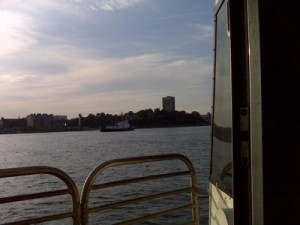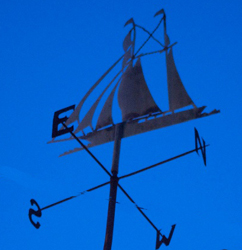Seismologists have measured minute movements within two massive tectonic plates over 25 miles below the Puget Sound basin of Washington State. Analysis of these tremor patterns, called “episodic tremor and slip”, suggested that an earthquake on the order of magnitude of 9.0 on the Richter scale, possibly followed by a tsunami, could strike much closer to Seattle than was indicated by earlier disaster scenario models. The most powerful earthquake ever to strike North America, the Great Alaska earthquake of 1964, measured 9.2 and resulted in a tsunami that struck that struck the northwestern United States. The 1906 San Francisco earthquake, the benchmark for earthquake fatalities, is believed to be an 8.3. The take-home message is that our understanding of catastrophic risks is changing owing to new threat scenarios. It is best not to assume anything based on geographic locale and instead prepare for the everyday disaster, which is the universal experience.
Archive for August, 2009
New Earthquake Scenario Model for the Seattle Area
Tuesday, August 18th, 2009Banks Review Dispute Resolution
Sunday, August 16th, 2009Bank of America Corp. announced that it will no longer require its credit card and bank account customers to waive their rights to litigate disputes on their accounts. The mandatory arbitration clauses, a common feature in bank contracts, are coming under scrutiny by Congress and regulators. In Prepare for the Worst, Plan for the Best: Disaster Preparedness and Recovery for Small Businesses (Wiley, second edition, 2008, paperback, 2009), I recommended requesting arbitration as a more cost-effective means of resolving disputed insurance claims that often follow major disasters. If that process fails, you can then consider other options. But I was careful to point out that you should not waive any of your rights, including your right to sue. The controversy around mandatory arbitration for bank account disputes ignited when the Minnesota Attorney General brought suit against National Arbitration Forum, a leading dispute resolution firm, alleging that it had undisclosed ties to the debt collection industry. If this allegation is proven, it indicates that the deck is stacked against consumers and small businesses in mandatory arbitration by an arbiter that is anything but neutral. Perhaps anticipating the outcome of this litigation, banks and credit card companies are reviewing their policies to determine how best to respond. One consumer advocacy group stated that banks will offer fairer, more transparent products terms if they can no longer be shielded by arbitration.
Hudson River Recovery Effort
Tuesday, August 11th, 2009Nine people were killed Saturday, when a private plane collided with a sightseeing helicopter over the Hudson River. I saw the aftermath of the tragedy from my home office when I was on the phone as a guest on a live talk news program. For the past several days, divers from the New York Police Department and the Army Corps of Engineers have been working to recover the bodies of those who died in the crash as well as the remnants of the aircraft for official inspection by the National Transportation Safety Board. My commute home today was delayed as the ferry boats across the Hudson River were slowed to accommodate the U.S. Coast Guard boats involved in the recovery effort. It was a sobering reminder of a terrible tragedy.
Typhoon Morakot Threatens China
Saturday, August 8th, 2009We know from our experience with hurricanes in the Gulf Coast the long-term damage that can be wrought on vulnerable populations. But the consequences are even more devastating to developing countries that have fewer social safety nets for victims of natural disasters. This week, the National Disaster Coordinating Council reported that the tier of Typhoon Morakot killed ten people in the Philippines. Five casualties were tourists and their guides who were swept into the water. The heavy rains were responsible for more than ten landslides that destroyed or damaged close to 30 properties. The storm then picked up wind speeds of 92 mph and made landfall in Taiwan where it killed two people and left behind 51 inches of rainfall. The forecast calls for the storm to drop another 39 inches of rain on Taiwan. The damage caused by the heavy rainfall is amplified by the recent drought that left the ground unable to absorb water, such that flooding results. China is next in the path of Typhoon Morakot. Chinese authorities have already begun evacuating residents of islands along the coastal storm path. Let’s hope that the storm does not claim any more lives and we should all be prepared to give whatever we can to relief efforts.
Flooding in Kentucky, Drought in Texas
Thursday, August 6th, 2009Louisville, Kentucky was flooded when a storm left the area with more than seven inches of rain, resulting in flash flooding, and power outages. Thankfully, no casualties or serious injuries resulted from the storm, but the rainfall overwhelmed the area’s public infrastructure and caused major disruptions to local small businesses. The mayor of Louisville estimates that the main library sustained $1 million in damages when flooding destroyed books. Firemen led water rescue efforts for people stranded as animal shelters evacuated animals to minimize casualties due to drowning.
At the same time, Texas is experiencing a severe drought with 100-degree temperatures in an area that includes Austin, Dallas, Houston and San Antonio. As a result, mandatory water restrictions have been imposed on 230 Texas public water systems, which prohibit practices such as watering lawns or refilling swimming pools. It bears repeating; prepare for the more frequent disasters, such as drought and flash flooding, as such measures will yield a more immediate benefit against a more imminent threat at more reasonable cost.
Experts Dial Down Hurricane Forecasts
Wednesday, August 5th, 2009The forecasting team at Colorado State University revised its forecast for the 2009 Atlantic storm season, reducing the number of predicted hurricanes from eleven to four. Based on El Niño events early in the season (the season begins on June 1, but historically, the date of the first hurricane is typically August 14), the storm season is likely to be calmer than originally thought. El Niño is the phenomenon of Pacific Ocean warming that affects global weather patterns. It tends to correlate with increased vertical wind shear that weakens tropical storms before they can form hurricanes. The forecast now calls for ten named tropical storms, with four likely to become hurricanes and two of the four expected to become major hurricanes (meaning wind speeds of 111 mph or more). This is welcome news at any time, but particularly in this difficult economy, with fewer financial resources available to support disaster relief efforts.
Mobile Data Outage Disrupts Small Businesses
Sunday, August 2nd, 2009AT&T experienced a substantial mobile data area-wide EDGE/3G outage in the Northeast and Midwest, which disrupted iPhone service as well. If your business was affected and you ask your AT&T service representative, the company will credit $25 to your account. But be sure to request the credit, because it appears that the company is not volunteering the credit. The way to minimize disruption from such inevitable mishaps is to have redundant systems in place to deal with third-party failure. I have two separate wireless providers for my business, such that if one fails, I use the other. For a relatively modest fee, I build in some contingency for mobile data services, which can be a lifeline for small businesses.


